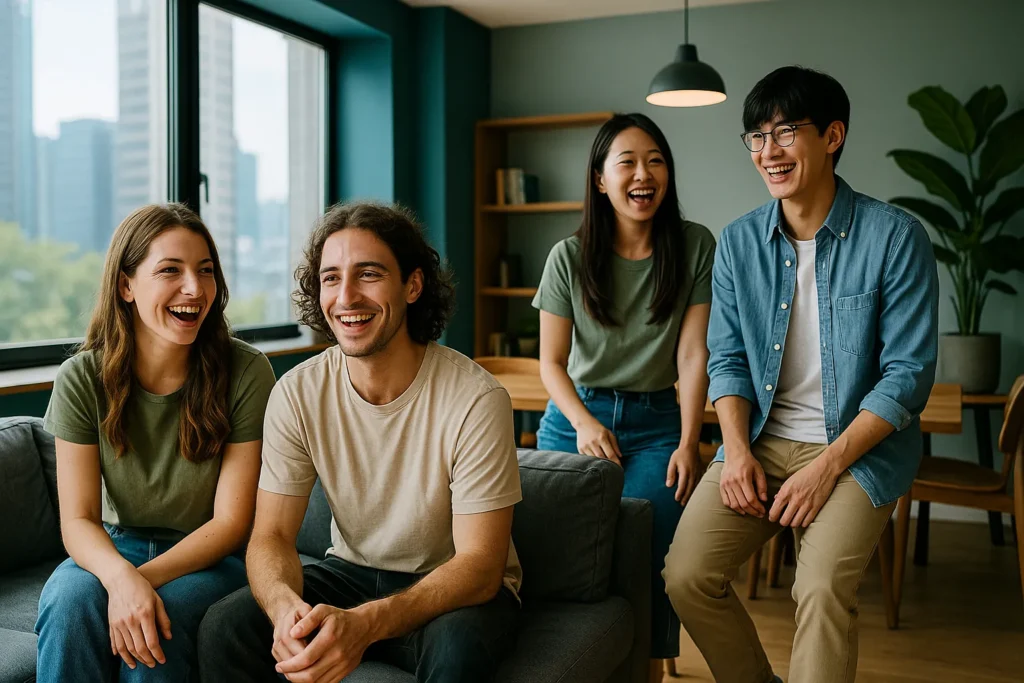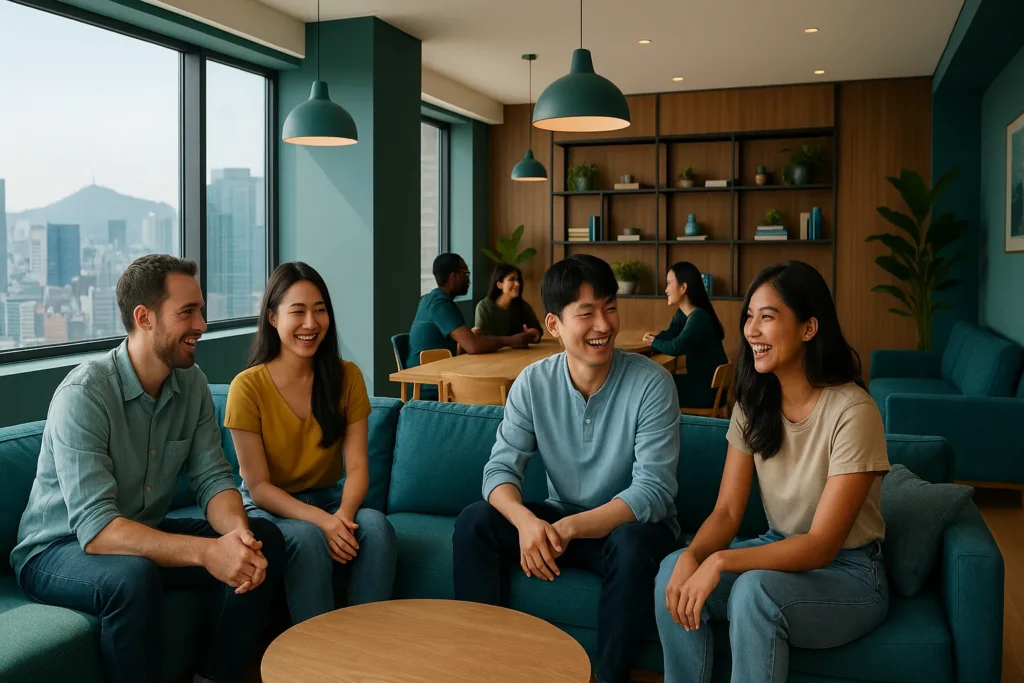
Your Ultimate Guide to Co-Living Spaces in Korea for Foreigners 🇰🇷🏠
**Published:** September 28, 2025
Moving to South Korea is *super* exciting, but let’s be real—finding the right long-term housing can feel like a level-99 quest, especially with all the talk about complex deposit systems like ‘Jeonse’ and ‘Wolse’ [[2](https://mangrove.city/blog/what-are-coliving-houses-and-where-can-i-find-them-in-seoul-62696)]. I know, I was there too! Between navigating unfamiliar contracts and trying to find an affordable, stable, and comfortable place, it can get overwhelming [[6](https://www.staykorea.org/korea-travel/foreigners-long-term-housing-korea-2025/)].
The good news? The rise of **co-living spaces** in Seoul and across Korea has totally changed the game for international residents! They offer a perfect mix of privacy, community, and simplicity. Ready to dive into the best options and see why co-living might be your ideal Korean home? Let’s go! 😊
What Exactly is Co-Living in the Korean Context? 💡
If you’re new to the concept, co-living is essentially modern, community-focused housing. Think of it as a significant upgrade from hostels or Goshiwons, offering the budget-friendliness of shared housing with the perks of a modern apartment [[4](https://coliving.com/south-korea)].
For foreigners, co-living spaces solve two major issues simultaneously:
- Simplifying Contracts: They bypass the complex, high-deposit housing model common in Korea, often replacing it with an all-inclusive monthly fee that covers rent, utilities, and Wi-Fi [[2](https://mangrove.city/blog/what-are-coliving-houses-and-where-can-i-find-them-in-seoul-62696)].
- Instant Community: It’s a built-in social network, which is super helpful when you first move to a new country like Korea! Many spaces host weekly or monthly events [[3](https://www.newgravite.com/best-co-living-spaces-in-seoul/)].
Co-living houses are often seen as the perfect choice for international students in Seoul, as they combine comfort, community, and security, simplifying the transition to academic life [[5](https://mangrove.city/blog/why-coliving-houses-are-the-perfect-choice-for-seoul-international-students-63260)].
Finding Your Vibe: Top Co-Living Types in Seoul ✨
Seoul’s co-living scene is surprisingly diverse! Depending on your lifestyle—whether you’re a quiet bookworm or a social butterfly—there’s a perfect fit. Here are the main types you’ll encounter:
-
The Classic Share House:
This is the most common model. You get your own private room (cozy bedroom, yay!) but share the main facilities like the living room and kitchen with housemates. Places like “Hoppin House” or “Seoul Nooks” often fit this cozy vibe [[3](https://www.newgravite.com/best-co-living-spaces-in-seoul/)]. It’s great for meeting people and having a built-in social life.
-
Studio/Apartment Style Co-Living:
If you prefer more solitude, this style is fantastic. Places like “LIFE Co-Living Space” offer private, fully-equipped studios but still grant access to shared facilities like lounges, kitchens, and rooftop gardens [[6](https://softervolumes.com/life-co-living-space-seoul/)]. You get privacy *and* community events! You might even find some options near popular spots like Itaewon [[4](https://coliving.com/south-korea)].
-
Themed/Niche Co-Living:
Some spaces cater to specific interests, like “Local Stitch” for creatives [[3](https://www.newgravite.com/best-co-living-spaces-in-seoul/)] or houses focused on language exchange. This is perfect if you want to be surrounded by people in your field or with similar hobbies.
Checklist: What to Look for When Choosing Your Co-Living Space 📝
Before signing anything, here’s a quick checklist based on what most expats tell me is *really* important:
| Category | What to Confirm |
|---|---|
| Contract/Fees | Is the deposit refundable? Are utilities (gas, electric, water) truly included in the monthly fee? Are there any hidden cleaning or maintenance fees? |
| Privacy & Guests | Do you have a private studio/bathroom, or is the room private but the bath shared? What is the policy on overnight guests? (This is often a major concern!) |
| Location & Commute | How close is it to your university or office? Is it near a major subway line (e.g., Line 2 for Gangnam/Hongdae)? Living near Yonsei University (Yeondae) might mean a livelier, younger community, for example [[5](https://borderless-house.com/kr/sharehouse/yeondae/)]. |
| Community Vibe | Do they organize events? Is it a mix of international and local residents? Use the directory for reliable spaces to check for a good social atmosphere [[1](https://expatguidekorea.com/seoul,blog,deal,best,seoul-event/coliving-spaces-in-seoul)]. |
Be careful not to confuse modern co-living with traditional ‘Goshiwons’ or ‘Hasukjips’ which, while cheap, may not offer the same level of privacy, quality, or community focus that co-living spaces provide. Always check the room and shared facilities in person or via detailed video tours!
Co-Living vs. Traditional Housing: The Foreigner’s Advantage 🏆
Why are so many international residents, from digital nomads to students, ditching the old ways for co-living? It largely comes down to eliminating the biggest pain points of Korean housing:
The Deposit Nightmare: Solved! 🔑
- Traditional Housing: Requires a huge initial security deposit (often ₩5M to ₩20M, or more) for ‘Wolse’ (monthly rent) or an astronomical sum for ‘Jeonse’ (lump-sum deposit) [[2](https://mangrove.city/blog/what-are-coliving-houses-and-where-can-i-find-them-in-seoul-62696)].
- Co-Living: Minimal or no security deposit. You just pay your first month’s rent and perhaps a small, one-time admin/move-in fee. This keeps your cash flow healthy!
*This financial simplicity alone makes co-living a revolutionary solution designed specifically for international needs* [[5](https://mangrove.city/blog/why-coliving-houses-are-the-perfect-choice-for-seoul-international-students-63260)].
It’s really about the modern convenience. You’re not just renting a room; you’re buying into a simplified life where the Wi-Fi is fast, the bills are sorted, and there’s a good chance you’ll have a comfortable lounge or a rooftop garden waiting for you [[6](https://softervolumes.com/life-co-living-space-seoul/)]. Seriously, traditional apartments rarely have these kinds of shared social spaces!
Quick Summary: Your Korean Co-Living Action Plan 📝

To wrap up, co-living is arguably the easiest, most rewarding way for a foreigner to find long-term housing in South Korea. Here’s what you need to do next:
- Research Reliable Directories: Use trusted online directories to browse the most reliable and affordable co-living spaces in Seoul and other cities [[1](https://expatguidekorea.com/seoul,blog,deal,best,seoul-event/coliving-spaces-in-seoul)].
- Define Your Needs: Decide if you need a fully private studio (e.g., LIFE Co-Living) or if a shared-facility house (e.g., Hoppin House, Seoul Nooks) suits your budget and social needs better [[3](https://www.newgravite.com/best-co-living-spaces-in-seoul/)].
- Check Commute Time: Prioritize location. A great house with a two-hour commute is no fun! Areas like Yeondae (near Yonsei University) or Itaewon are popular choices for their energy and accessibility [[5](https://borderless-house.com/kr/sharehouse/yeondae/)], [[4](https://coliving.com/south-korea)].
Frequently Asked Questions ❓
I really hope this guide helps you skip the housing stress and jump straight into the fun of living in Korea! Co-living truly offers the best balance of independence and community, especially when you’re starting out.
Do you have any experience with co-living in Seoul? Or, if you have questions, drop them in the comments below! Happy house hunting! 😊
